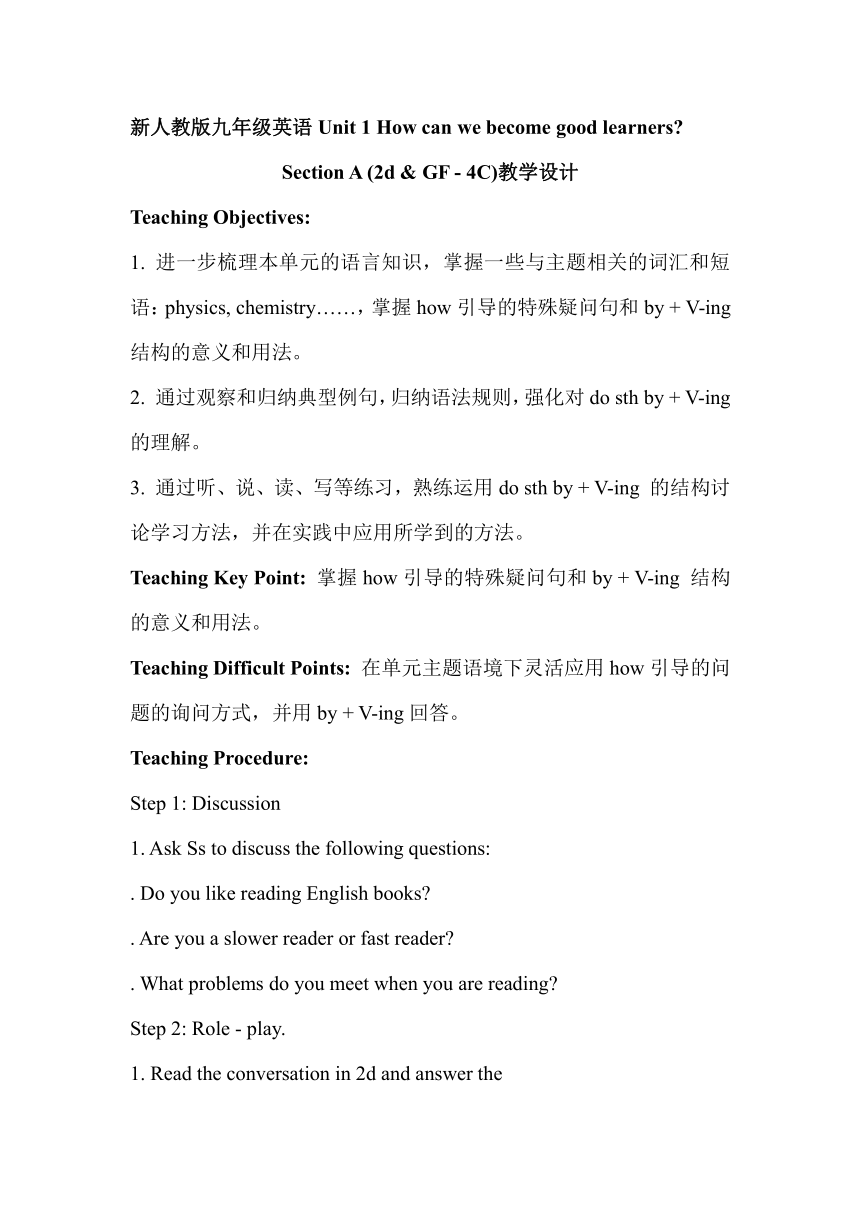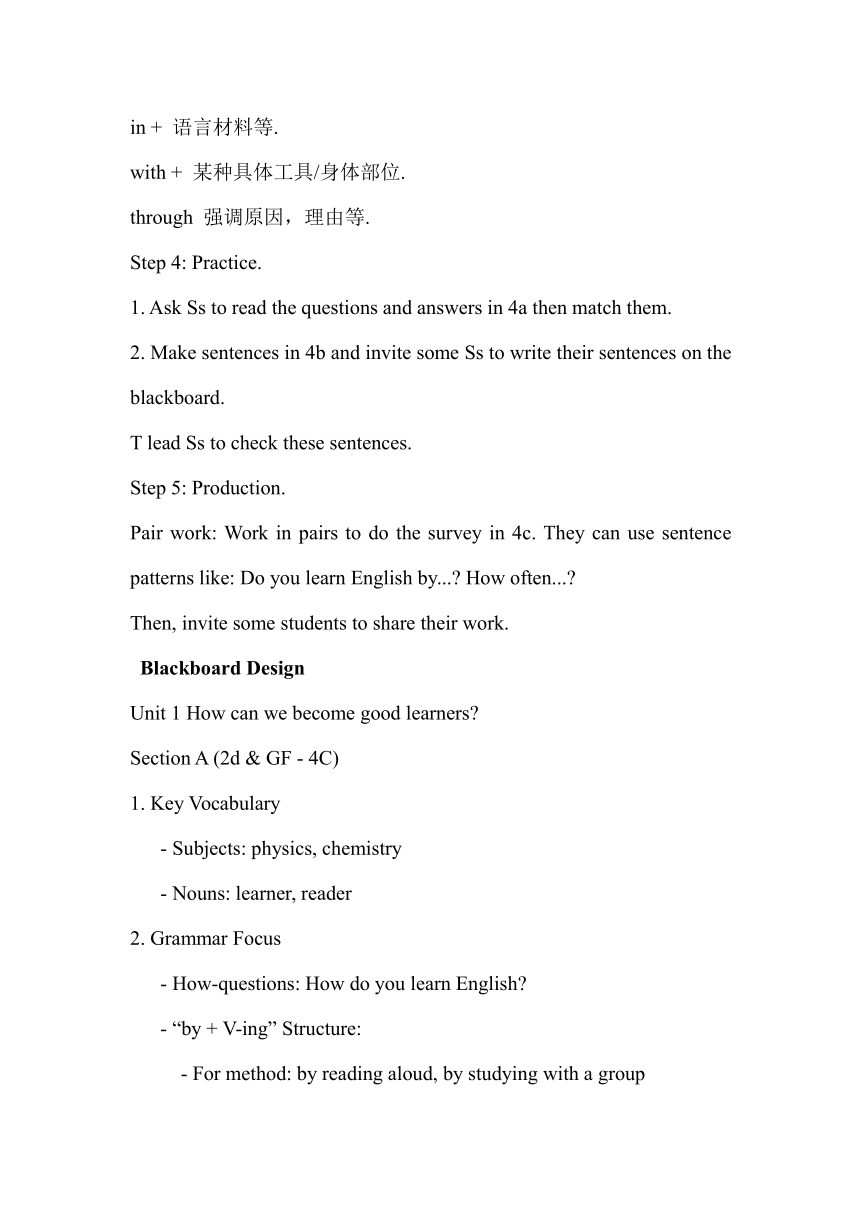新人教版九年级英语Unit 1 How can we become good learners Section A (2d & GF - 4C)教学设计
文档属性
| 名称 | 新人教版九年级英语Unit 1 How can we become good learners Section A (2d & GF - 4C)教学设计 |  | |
| 格式 | docx | ||
| 文件大小 | 14.6KB | ||
| 资源类型 | 教案 | ||
| 版本资源 | 人教新目标(Go for it)版 | ||
| 科目 | 英语 | ||
| 更新时间 | 2025-08-23 09:17:26 | ||
图片预览



文档简介
新人教版九年级英语Unit 1 How can we become good learners
Section A (2d & GF - 4C)教学设计
Teaching Objectives:
1. 进一步梳理本单元的语言知识,掌握一些与主题相关的词汇和短语:physics, chemistry……,掌握how引导的特殊疑问句和by + V-ing 结构的意义和用法。
2. 通过观察和归纳典型例句,归纳语法规则,强化对do sth by + V-ing 的理解。
3. 通过听、说、读、写等练习,熟练运用do sth by + V-ing 的结构讨论学习方法,并在实践中应用所学到的方法。
Teaching Key Point: 掌握how引导的特殊疑问句和by + V-ing 结构的意义和用法。
Teaching Difficult Points: 在单元主题语境下灵活应用how引导的问题的询问方式,并用by + V-ing回答。
Teaching Procedure:
Step 1: Discussion
1. Ask Ss to discuss the following questions:
. Do you like reading English books
. Are you a slower reader or fast reader
. What problems do you meet when you are reading
Step 2: Role - play.
1. Read the conversation in 2d and answer the
questions:
. What makes Jack feel a little nervous
. What's Jack's problem when he reads And What does Annie suggest
. What's Jack's problem with words And what's Annie's advice
2. Watch the video of this conversation and read after it.
3. Fill in the blanks according to the conversation.
Step 3: Presentation.
1. Ask Ss to read the sentences in G F and discuss the usage of "by".
by 的用法
① by + V - ing 表示方式、手段等。“通过,借助,用”
② by + 交通工具. “乘/驾驶/坐……”
③ by + 时间 “不迟于,在……之前;到……为止”
I must be in bed by ten o'clock.
④ by + 地点 “在……旁边,靠近”
⑤ “从……经过” He walked by me without speaking.
⑥ 用于被动语态,后接动作的执行者,意为“由;被”
This book is written by Lu Xun.
by 组成的短语:
by the way by and by by hand
by chance by mistake by oneself.
by / in / with / through.
by + 某种方式/手段.
in + 语言材料等.
with + 某种具体工具/身体部位.
through 强调原因,理由等.
Step 4: Practice.
1. Ask Ss to read the questions and answers in 4a then match them.
2. Make sentences in 4b and invite some Ss to write their sentences on the blackboard.
T lead Ss to check these sentences.
Step 5: Production.
Pair work: Work in pairs to do the survey in 4c. They can use sentence patterns like: Do you learn English by... How often...
Then, invite some students to share their work.
Blackboard Design
Unit 1 How can we become good learners
Section A (2d & GF - 4C)
1. Key Vocabulary
- Subjects: physics, chemistry
- Nouns: learner, reader
2. Grammar Focus
- How-questions: How do you learn English
- “by + V-ing” Structure:
- For method: by reading aloud, by studying with a group
- Multiple Usages of “by”:
- By + transportation: by bus, by bike
- By + time: by 10 o’clock
- By + place: by the window
- Passive voice: This book was written by Lu Xun.
3. Phrases with “by”
by the way, by and by, by hand, by chance, by mistake, by oneself
4. Class Activities
- Role-play (2d conversation)
- Match & Make Sentences (4a, 4b)
- Pair Survey (4c: Do you learn English by... How often... )
Teaching Reflection
Today’s lesson aimed to help students master the “by + V-ing” structure and discuss learning methods. Here’s a reflection on its strengths, weaknesses, and improvements:
Strengths
1. Structured Procedure: The lesson followed a logical flow—discussion → role-play → grammar presentation → practice → production. This scaffolding helped students build knowledge step by step.
2. Engaging Role-Play: The 2d role-play, combined with video listening and repetition, enhanced students’ pronunciation and contextual understanding of “by” for talking about learning challenges and advice.
3. Clear Grammar Explanation: The multi-usage illustration of “by” (method, transportation, time, place, passive voice) was clear, with examples that students could easily relate to.
Weaknesses
1. Practice Gaps: Some students struggled to create “by + V-ing” sentences independently in 4a/4b. More guided practice (e.g., shared writing examples) was needed before independent work.
2. Time Management: The “Grammar Presentation” segment ran longer than planned, reducing time for the “Production” stage (4c survey). Many pairs couldn’t fully finish or share their work.
3. Uneven Participation: Active students dominated discussions, while quieter students had fewer opportunities to speak.
Improvements for Future Lessons
1. Enhance Guided Practice: Add more controlled exercises (e.g., fill-in-the-blanks with “by + V-ing”) to ensure all students grasp the structure before independent tasks.
2. Refine Time Allocation: Set stricter time limits for each section. Simplify less essential explanations to reserve more time for speaking practice.
3. Boost Inclusive Participation: Use structured pair/group tasks (e.g., assigned roles: “interviewer” vs. “respondent” in 4c) to encourage quieter students to contribute.
Overall, the lesson met most objectives but requires adjustments in pacing and student engagement to be more effective.
Section A (2d & GF - 4C)教学设计
Teaching Objectives:
1. 进一步梳理本单元的语言知识,掌握一些与主题相关的词汇和短语:physics, chemistry……,掌握how引导的特殊疑问句和by + V-ing 结构的意义和用法。
2. 通过观察和归纳典型例句,归纳语法规则,强化对do sth by + V-ing 的理解。
3. 通过听、说、读、写等练习,熟练运用do sth by + V-ing 的结构讨论学习方法,并在实践中应用所学到的方法。
Teaching Key Point: 掌握how引导的特殊疑问句和by + V-ing 结构的意义和用法。
Teaching Difficult Points: 在单元主题语境下灵活应用how引导的问题的询问方式,并用by + V-ing回答。
Teaching Procedure:
Step 1: Discussion
1. Ask Ss to discuss the following questions:
. Do you like reading English books
. Are you a slower reader or fast reader
. What problems do you meet when you are reading
Step 2: Role - play.
1. Read the conversation in 2d and answer the
questions:
. What makes Jack feel a little nervous
. What's Jack's problem when he reads And What does Annie suggest
. What's Jack's problem with words And what's Annie's advice
2. Watch the video of this conversation and read after it.
3. Fill in the blanks according to the conversation.
Step 3: Presentation.
1. Ask Ss to read the sentences in G F and discuss the usage of "by".
by 的用法
① by + V - ing 表示方式、手段等。“通过,借助,用”
② by + 交通工具. “乘/驾驶/坐……”
③ by + 时间 “不迟于,在……之前;到……为止”
I must be in bed by ten o'clock.
④ by + 地点 “在……旁边,靠近”
⑤ “从……经过” He walked by me without speaking.
⑥ 用于被动语态,后接动作的执行者,意为“由;被”
This book is written by Lu Xun.
by 组成的短语:
by the way by and by by hand
by chance by mistake by oneself.
by / in / with / through.
by + 某种方式/手段.
in + 语言材料等.
with + 某种具体工具/身体部位.
through 强调原因,理由等.
Step 4: Practice.
1. Ask Ss to read the questions and answers in 4a then match them.
2. Make sentences in 4b and invite some Ss to write their sentences on the blackboard.
T lead Ss to check these sentences.
Step 5: Production.
Pair work: Work in pairs to do the survey in 4c. They can use sentence patterns like: Do you learn English by... How often...
Then, invite some students to share their work.
Blackboard Design
Unit 1 How can we become good learners
Section A (2d & GF - 4C)
1. Key Vocabulary
- Subjects: physics, chemistry
- Nouns: learner, reader
2. Grammar Focus
- How-questions: How do you learn English
- “by + V-ing” Structure:
- For method: by reading aloud, by studying with a group
- Multiple Usages of “by”:
- By + transportation: by bus, by bike
- By + time: by 10 o’clock
- By + place: by the window
- Passive voice: This book was written by Lu Xun.
3. Phrases with “by”
by the way, by and by, by hand, by chance, by mistake, by oneself
4. Class Activities
- Role-play (2d conversation)
- Match & Make Sentences (4a, 4b)
- Pair Survey (4c: Do you learn English by... How often... )
Teaching Reflection
Today’s lesson aimed to help students master the “by + V-ing” structure and discuss learning methods. Here’s a reflection on its strengths, weaknesses, and improvements:
Strengths
1. Structured Procedure: The lesson followed a logical flow—discussion → role-play → grammar presentation → practice → production. This scaffolding helped students build knowledge step by step.
2. Engaging Role-Play: The 2d role-play, combined with video listening and repetition, enhanced students’ pronunciation and contextual understanding of “by” for talking about learning challenges and advice.
3. Clear Grammar Explanation: The multi-usage illustration of “by” (method, transportation, time, place, passive voice) was clear, with examples that students could easily relate to.
Weaknesses
1. Practice Gaps: Some students struggled to create “by + V-ing” sentences independently in 4a/4b. More guided practice (e.g., shared writing examples) was needed before independent work.
2. Time Management: The “Grammar Presentation” segment ran longer than planned, reducing time for the “Production” stage (4c survey). Many pairs couldn’t fully finish or share their work.
3. Uneven Participation: Active students dominated discussions, while quieter students had fewer opportunities to speak.
Improvements for Future Lessons
1. Enhance Guided Practice: Add more controlled exercises (e.g., fill-in-the-blanks with “by + V-ing”) to ensure all students grasp the structure before independent tasks.
2. Refine Time Allocation: Set stricter time limits for each section. Simplify less essential explanations to reserve more time for speaking practice.
3. Boost Inclusive Participation: Use structured pair/group tasks (e.g., assigned roles: “interviewer” vs. “respondent” in 4c) to encourage quieter students to contribute.
Overall, the lesson met most objectives but requires adjustments in pacing and student engagement to be more effective.
同课章节目录
- Unit 1 How can we become good learners.
- Section A
- Section B
- Unit 2 I think that mooncakes are delicious!
- Section A
- Section B
- Unit 3 Could you please tell me where the restroom
- Section A
- Section B
- Unit 4 I used to be afraid of the dark.
- Section A
- Section B
- Unit 5 What are the shirts made of?
- Section A
- Section B
- Review of Units 1-5
- Unit 6 When was it invented?
- Section A
- Section B
- Unit 7 Teenagers should be allowed to choose their
- Section A
- Section B
- Unit 8 It must belong to Carla.
- Section A
- Section B
- Unit 9 I like music that I can dance to.
- Section A
- Section B
- Unit 10 You're supposed to shake hands.
- Section A
- Section B
- Review of Units 6-10
- Unit 11 Sad movies make me cry.
- Section A
- Section B
- Unit 12 Life is full of the unexpected
- Section A
- Section B
- Unit 13 We're trying to save the earth!
- Section A
- Section B
- Unit 14 I remember meeting all of you in Grade 7.
- Section A
- Section B
- Review of Units 11-14
